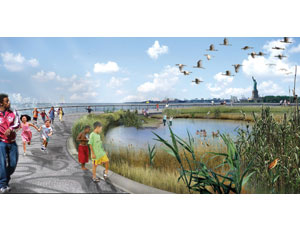...West 8, a landscape architecture firm founded 20 years ago in Rotterdam, Netherlands, which now has projects in Europe, Middle East, and Asia.

It took the company eight years of trying to get a job in the U.S. As an outsider, Jerry Van Eyck, the principal of West 8’s New York office has observed some differences between doing business at home and in New York: “In general things are much more institutionalized over here. All these agencies have their regulations and rules, and of course we want to comply with all these rules,” he says. “And we’re constantly astonished by the motivation of the public to organize themselves into different groups – it’s very impressive. It’s different in the Netherlands – you get to deal with a couple of prominent city people and then you just build it.”
West 8 has also replaced Frank Gehry on a $13 million park project in Miami, in July. Gehry has not had a very good year, incidentally – in June, he was pushed off the 22-acre Atlantic Yards project in Brooklyn, replaced by Ellerbe Becket, and while the developer has cited cost as the impetus, some speculate that the lack of a landscape architect in Gehry’s original plans may have played a part.
“If Gehry had a landscape architect in earlier phases of the project, it probably would have encountered less community resistance,” says Drake. “I think that role was overlooked because everyone was star-struck. Bringing in [landscape architect] Laurie Olin was problematic – the damage was already done, you couldn’t patch it.”
Joe DePlasco, a spokesperson for Forest City Ratner Cos., the New York-based developer on the project, wrote in an e-mail that while the new designs for first phase of the project were not ready at press time, the eight-acre public land component are part of the second phase of the project. He declined comment on Gehry or Olin.
Sharing the BurdenCooke points out that successful landscape architecture work is often the result of effective collaboration in private-public partnerships, such as the New York Restoration Project, founded in 1995 by actress Bette Midler. The NYRP is perhaps best known for rescuing 114 community gardens the city planned to auction off in 1999 – forever earning Midler the unconditional love of most residents of such neighborhoods as the East Village. But the group is also behind city park cleanup and restoration, development of new parks, and youth environmental education programs. NYRP partners with the Parks department, but also relies on private funding.
The most visible example of such public-private partnerships is the Brooklyn Bridge Park. The current 17-acre site on the Brooklyn side of the Manhattan Bridge will be eventually transformed into a 76-acre continuous waterfront park along a 1.3-mile stretch from DUMBO to Atlantic Avenue – Brooklyn’s most significant new green space project since Prospect Park was constructed 135 years ago.
To fund the $350 million construction, and the $16.1 million maintenance and operations budget, the city (the piers of the park are owned by the PortAuthority) handed over a portion of the land to private development, which is expected to generate fees. This will include four new proposed residential buildings totaling 1,210 units, located at the land edges of the park and taking up about 10 percent of the entire acreage of the site, as well as a 225-room hotel, cafes and small retail development. Other revenue comes from revenue-generating elements within the park itself, such as cafes and recreational activities. The idea of funding operations and maintenance costs of parks without government support is catching on: Hudson River Park and Riverside South in New York, as well as several parks around the country, are all following similar models.
Outside the Urban Landscape Upstate New York landscape architects these days are working on university projects – particularly in response to a growing demand for state college education as the economy slows and people seek new careers – and other public projects, including streetscapes to wind turbine sites. The profession will also likely play a major role in the region’s planned shale gas deposit exploration, according to Michael Haas, president of the Upstate New York ASLA and founder of Binghamton, N.Y.-based Haas Landscape Architects.
“From the landscape architect’s standpoint, we see the value in helping with site plans and storm water management, which is a big thing because they basically rape the sites,” Haas says. “There are...

Post a comment to this article
Report Abusive Comment